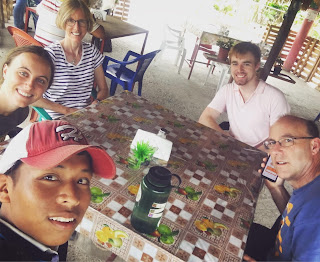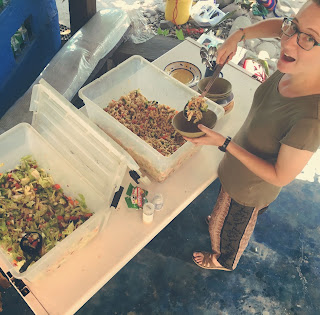I went back to Cerro Gallina twice with the Sustainable Agriculture Systems (SAS) staff. As you may remember they did not get a follow-up WASH volunteer last year upon my departure for various reasons, one being that there was too much division amongst families for a water or sanitation project to be successful, but the gente wanted an agriculture volunteer. The meetings went well, and I hope they are able to get a volunteer because I see lots of potential in the areas of cacao, corn, and bean production, home gardens, and marketing of their products. But going back to my site was shocking... it was so dry. Sooooo dry. Because of the drought and wind, multiple routine finca fires had gotten out of control, burning aqueduct tubes and getting dangerously close to houses. The area in front of Eduardo and Luisa's house looked like a nuclear wasteland, pure black ash. The namesake Hen Hill, above the community, was half burned. It used to be completely tree covered, and now it is half trees and half charred stumps. I asked my gente about this, in dismay, and turns out some people from Cerro Mesa burned here so they could plant. But if they cut down the trees, all of the water in your springs is gonna dry up! I cried. This can't be legal, this hill should be protected land where no one is allowed to burn. My gente agreed, but what can we do at this point? Then we hiked down to the spring, where I got all of my water last year. Although the flow was reduced in the dryest months, I was still always able to fill up my buckets. This time, it was barely trickling. I couldn't believe it, it would take hours to fill a single bucket at this rate. If it had been this dry last year....man oh man. I honestly may have thrown in the towel and said, "I'm outta here. I can't do this anymore."
The meeting in Gallina was on Thursday April 4th. For the next few days I couldn't get the image of the dry spring out of my mind. I cursed the summer and prayed please God, make it rain!!! On Sunday April 7th it started to rain. And just like that, it was winter again. It's a temporary consolation... I am relieved I never have to withstand a hot, dusty Panamanian summer again, but my gente have to deal with it every year, and it's going to keep getting longer and dryer as climate change continues to accelerate. :( :(
When I have time off from site ID I have been continuing to experiment in the kitchen, mainly with yeast breads and fermented drinks. A new vegetable stand opened up in San Felix last October, and the women who run it are amazing, bringing colorful produce from the Chiriquí highlands. They even have some of my favorites that are harder to find, like spinach and eggplant. They brought me fresh dill on special request so I made three jars of homemade dill pickles and they were so good.
I acquired some California red worms from a SAS volunteer who has a compost project going in her site and have started worm composting at my house, and I love it. I toss in small handfuls of food scraps chopped into tiny bits, egg shells, coffee grounds, etc and the worms eat it up, then their byproduct (worm poop!) becomes a rich compost. My idea is that once they reproduce enough to have sizable population in my bucket, volunteers can take handfuls of worms to their sites to start their own buckets, then pass worms on to their gente too. Why toss food scraps when they can be turned into free organic fertilizer?!
This past Sunday was Panama's quinquennial election. Official campaigning is not allowed until two months out from voting, so on March 5th empezó la locura - political party flags appeared, posters and banners were everywhere, and ads for candidates even began popping up on my Facebook newsfeed. One day I was waiting near Hato Pilón for a chiva and a truck full of Cambio Democrático party members stopped. They appeared to be joyriding up and down the mountain, shouting and waving their flags. They gave me a free ride, so that was nice. Since every position from president to mayor is up for (re)election at the same time, everyone and their neighbor seemed to be running for some office. Actually though, my next-door neighbor was running for representative. He was constantly running around leading up to the election, and surprised me when the night before he stopped and gave us a heartfelt speech on my porch about how he wanted to make the district of San Félix better for everyone, not just the wealthy and influential, and even if he lost he was going to continue fighting for equality. He ran as an independent and ended up losing, and apparently the political party of the winner was giving rides to the polls and bribing voters with $20 per vote for their candidate... On the topic of corruption, the 2009-2014 Panamanian president Ricardo Martinelli was running for mayor of Panama City, and had quite a following. Recall that he was extradited from Miami to Panama in 2017 on embezzlement charges and awaits his trial in jail. But then soon before the election, it was determined that he was actually not eligible to run because he didn't meet the residency requirement for mayor, because he was in JAIL! It sounds ridiculous but it's true haha. The new president is Nito Cortizo from the Partido Revolucionario Democrático, the center-left party that was started by President Omar Torrijos in 1979. I am optimistic about Nito because he visited the Comarca multiple times during his campaign and really seems to care about indigenous people! Speaking of Omar Torrijos, I recently read Confessions of an Economic Hitman by John Perkins. It gives a behind-the-scenes look into United States interventions in various countries, and has several chapters about Panama, Torrijos, and the events that transpired after the 1976 Torrijos-Carter treaties that turned control of the canal over to Panama. This book blew my mind and I couldn't put it down. You have to read it if you haven't yet, and please let me know if you do, I want to hear your thoughts!
Dad, Mom, and Brendan came to Panama! In Panama City, we hiked Cerro Ancón where we saw a baby sloth, visited the canal, Casco Viejo, the fish and artisan markets, and walked the Cinta Costera. We visited my host family in Santa Rita on the way to Santa Fé, where we stayed in a little bed & breakfast up in the misty mountains for a night. We hiked to see a waterfall which was underwhelming but the rainforest along the way was beautiful as always. Then we went to Santa Catalina, a little rustic surf town, where you can catch boats to Coiba National Park. We did some snorkeling at Coiba, saw two wild crocodiles, and tried surfing. It was a wonderful week of lots of delicious food, card games, and getting to share this country that has become home to me with my family!
And now, for some photos:
One of the three aforementioned barricades, the first two were made of fallen trees and this one was made of a miscellaneous assortment of things: PVC pipe, wheelbarrow, desk, rice pilón, metal crossbars... You can see the Ministry of Education car in the background, the new unfinished school to the left and the temporary school to the right.
I finally made it to a balsería! This is a traditional celebration in the Comarca that takes place a few times each year during the dry months. Men "fight" by taking turns throwing logs at each other's legs and trying to dodge the incoming logs. Women also participate, but by fistfighting! Copious amounts of chicha fuerte are served and homemade horns made of conch shells and turtle shells are constantly blared. I went with a bunch of volunteers. We drank chicha out of totumas (miraculously I didn't get diarrhea, I think it was the fermentation), blew horns, and a couple of the guys even fought balsa! It was loud, dusty, chaotic, and hot as hell but quite worthwhile to experience this unique Ngäbe event. This photo is of a guy wearing a nagua over his clothes (to soften the blow when the balsa log gets hurled at your calf) and a typical backpack, made out of a stuffed wild feline.Hiking to help out Colin and his water committee repair a toma.
Lunch with the fam and Dionicio in San Félix! One of many selfies snapped by Dionicio.
A hammock not made for normal-sized humans
Visiting Milvia in Santa Rita!
On the lancha to Isla Coiba.
Helped facilitate a Comarca WASH weekend retreat at the beach - we served pasta and salad in plastic storage bins because we didn't have bowls big enough for 16 people.
Hiking to a potential new community. I was in the clouds the whole way, felt like I was in a terrarium. So lovely.
Coiba Island! Fulfilling a Panamanian dream to visit here.
The four WASH RLs at site announcement for the new group of volunteers, G84.











No comments:
Post a Comment